Red Quinoa Hydrolysates with Antioxidant Properties Improve Cardiovascular Health in Spontaneously Hypertensive Rats
Abstract
1. Introduction
2. Materials and Methods
2.1. Preparation of Quinoa Hydrolysate
2.2. General Protocol in Spontaneously Hypertensive Rats
2.3. Systolic Blood Pressure Measurement
2.4. Somatic Sensitivity: Von Frey Hair Test
2.5. Oxidative Stress Biomarkers
2.6. Histopathological Analysis
2.7. Statistical Analysis
3. Results and Discussion
3.1. Effect of Red Quinoa Hydrolysate Administration on Body Weight and Food and Water Intake
3.2. Effect of Red Quinoa Hydrolysate Administration on Blood Pressure
3.3. Effect of Red Quinoa Hydrolysate Administration on Tactile Sensitivity
3.4. Effect of Red Quinoa Hydrolysate Administration on Organ Weight and Histology
3.5. Effect of Red Quinoa Hydrolysate Administration on Oxidative Stress
4. Conclusions
Author Contributions
Funding
Institutional Review Board Statement
Informed Consent Statement
Data Availability Statement
Conflicts of Interest
References
- NCD Countdown 2030 Collaborators. NCD Countdown 2030: Worldwide Trends in Non-Communicable Disease Mortality and Progress towards Sustainable Development Goal Target 3.4. Lancet; Elsevier: Amsterdam, The Netherlands, 2018; Volume 392, pp. 22–28. [Google Scholar]
- Roth, G.A.; Mensah, G.A.; Johnson, C.O.; Addolorato, G.; Ammirati, E.; Baddour, L.M.; Barengo, N.C.; Beaton, A.Z.; Benjamin, E.J.; Benziger, C.P.; et al. Global Burden of Cardiovascular Diseases and Risk Factors, 1990–2019: Update from the GBD 2019 Study. J. Am. Coll. Cardiol. 2020, 76, 2982–3021. [Google Scholar] [CrossRef]
- Ruiz-Hernandez, A.; Tellez-Plaza, M.; Dominguez-Lucas, A.; Pichler, G.; Martin-Escudero, J.C.; Martinez-Garcia, F.; Vela-Bernal, S.; Redon, J. Population attributable risk for cardiovascular disease associated with hypertension. Results from the hortega follow-up study. J. Hypertens. 2018, 36, e27. [Google Scholar] [CrossRef]
- O’Donnell, M.J.; Xavier, D.; Liu, L.; Zhang, H.; Chin, S.L.; Rao-Melacini, P.; Rangarajan, S.; Islam, S.; Pais, P.; McQueen, M.J.; et al. Risk factors for ischaemic and intracerebral haemorrhagic stroke in 22 countries (the INTERSTROKE study): A case-control study. Lancet 2010, 376, 112–123. [Google Scholar] [CrossRef]
- Arnett, D.K.; Blumenthal, R.S.; Albert, M.A.; Buroker, A.B.; Goldberger, Z.D.; Hahn, E.J.; Himmelfarb, C.D.; Khera, A.; Lloyd-Jones, D.; McEvoy, J.W.; et al. 2019 ACC/AHA Guideline on the Primary Prevention of Cardiovascular Disease: A Report of the American College of Cardiology/American Heart Association Task Force on Clinical Practice Guidelines. J. Am. Coll. Cardiol. 2019, 74, e177–e232. [Google Scholar] [CrossRef] [PubMed]
- Unger, T.; Borghi, C.; Charchar, F.; Khan, N.A.; Poulter, N.R.; Prabhakaran, D.; Ramirez, A.; Schlaich, M.; Stergiou, G.S.; Tomaszewski, M.; et al. 2020 International Society of Hypertension Global Hypertension Practice Guidelines. Hypertension 2020, 75, 1334–1357. [Google Scholar] [CrossRef] [PubMed]
- Williams, B.; Mancia, G.; Spiering, W.; Agabiti, E.; Azizi, M.; Burnier, M. ESH Guía ESC/ESH 2018 sobre el diagnóstico y tratamiento de la hipertensión arterial. Rev. Española Cardiol. 2019, 72, 160.e1–160.e78. [Google Scholar] [CrossRef]
- Abegaz, T.M.; Shehab, A.; Gebreyohannes, E.A.; Bhagavathula, A.S.; Elnour, A.A. Nonadherence to antihypertensive drugs: A systematic review and meta-analysis. Medicine 2017, 96, e5641. [Google Scholar] [CrossRef]
- Poetsch, A.R. The genomics of oxidative DNA damage, repair, and resulting mutagenesis. Comput. Struct. Biotechnol. J. 2020, 18, 207–219. [Google Scholar] [CrossRef]
- Huang, M.-Z.; Li, J.-Y. Physiological regulation of reactive oxygen species in organisms based on their physicochemical properties. Acta Physiol. 2020, 228, e13351. [Google Scholar] [CrossRef]
- Ayala, A.; Muñoz, M.F.; Argüelles, S. Lipid peroxidation: Production, metabolism, and signaling mechanisms of malondialdehyde and 4-hydroxy-2-nonenal. Oxid. Med. Cell. Longev. 2014, 2014, 360438. [Google Scholar] [CrossRef]
- Perrone, A.; Giovino, A.; Benny, J.; Martinelli, F. Advanced Glycation End Products (AGEs): Biochemistry, Signaling, Analytical Methods, and Epigenetic Effects. Oxid. Med. Cell. Longev. 2020, 2020, 3818196. [Google Scholar] [CrossRef]
- Peighambardoust, S.H.; Karami, Z.; Pateiro, M.; Lorenzo, J.M. A Review on Health-Promoting, Biological, and Functional Aspects of Bioactive Peptides in Food Applications. Biomolecules 2021, 11, 631. [Google Scholar] [CrossRef]
- Pérez-Gregorio, R.; Soares, S.; Mateus, N.; de Freitas, V. Bioactive Peptides and Dietary Polyphenols: Two Sides of the Same Coin. Molecules 2020, 25, 3443. [Google Scholar] [CrossRef]
- Samtiya, M.; Aluko, R.E.; Dhewa, T.; Moreno-Rojas, J.M. Potential Health Benefits of Plant Food-Derived Bioactive Components: An Overview. Foods 2021, 10, 839. [Google Scholar] [CrossRef] [PubMed]
- Piñuel, L.; Boeri, P.; Zubillaga, F.; Barrio, D.A.; Torreta, J.; Cruz, A.; Vásquez, G.; Pinto, A.; Carrillo, W. Production of White, Red and Black Quinoa (Chenopodium quinoa Willd Var. Real) Protein Isolates and Its Hydrolysates in Germinated and Non-Germinated Quinoa Samples and Antioxidant Activity Evaluation. Plants 2019, 8, 257. [Google Scholar] [CrossRef] [PubMed]
- Shi, Z.; Hao, Y.; Teng, C.; Yao, Y.; Ren, G. Functional properties and adipogenesis inhibitory activity of protein hydrolysates from quinoa (Chenopodium quinoa Willd.). Food Sci. Nutr. 2019, 7, 2103–2112. [Google Scholar] [CrossRef]
- Mudgil, P.; Kilari, B.P.; Kamal, H.; Olalere, O.A.; FitzGerald, R.J.; Gan, C.-Y.; Maqsood, S. Multifunctional bioactive peptides derived from quinoa protein hydrolysates: Inhibition of α-glucosidase, dipeptidyl peptidase-IV and angiotensin I converting enzymes. J. Cereal Sci. 2020, 96, 103130. [Google Scholar] [CrossRef]
- Daliri, H.; Ahmadi, R.; Pezeshki, A.; Hamishehkar, H.; Mohammadi, M.; Beyrami, H.; Khakbaz Heshmati, M.; Ghorbani, M. Quinoa bioactive protein hydrolysate produced by pancreatin enzyme- functional and antioxidant properties. LWT 2021, 150, 111853. [Google Scholar] [CrossRef]
- Lopez Moreno, M.; Garcés-Rimón, M.; Castro, M. Obtención de Hidrolizados de Quinua con Actividad Antioxidante y su Efecto Sobre el Estrés Oxidativo Asociado a la Hipertensión Arterial. Doctoral Dissertation, Universidad Autónoma de Madrid, Madrid, Spain, 2022. [Google Scholar]
- Hwang, E.-S.; Choi, G.-Y.; Kim, K.J.; Kim, M.-J.; Lee, S.; Lee, J.-W.; Kim, D.-O.; Park, J.-H. Vitamin C Lowers Blood Pressure in Spontaneously Hypertensive Rats by Targeting Angiotensin-Converting Enzyme I Production in a Frequency-Dependent Manner. Evid.-Based Complement. Altern. Med. 2022, 2022, 9095857. [Google Scholar] [CrossRef]
- Martinez, C.S.; Alterman, C.D.C.; Vera, G.; Márquez, A.; Uranga, J.-A.; Peçanha, F.M.; Vassallo, D.V.; Exley, C.; Mello-Carpes, P.B.; Miguel, M.; et al. Egg White Hydrolysate as a functional food ingredient to prevent cognitive dysfunction in rats following long-term exposure to aluminum. Sci. Rep. 2019, 9, 1868. [Google Scholar] [CrossRef] [PubMed]
- Miguel, M.; López-Fandiño, R.; Ramos, M.; Aleixandre, A. Long-term intake of egg white hydrolysate attenuates the development of hypertension in spontaneously hypertensive rats. Life Sci. 2006, 78, 2960–2966. [Google Scholar] [CrossRef]
- Martinez, C.S.; Vera, G.; Ocio, J.A.U.; Peçanha, F.M.; Vassallo, D.V.; Miguel, M.; Wiggers, G.A. Aluminum exposure for 60days at an equivalent human dietary level promotes peripheral dysfunction in rats. J. Inorg. Biochem. 2018, 181, 169–176. [Google Scholar] [CrossRef] [PubMed]
- Manso, M.A.; Miguel, M.; Even, J.; Hernández, R.; Aleixandre, A.; López-Fandiño, R. Effect of the long-term intake of an egg white hydrolysate on the oxidative status and blood lipid profile of spontaneously hypertensive rats. Food Chem. 2008, 109, 361–367. [Google Scholar] [CrossRef]
- Ou, B.; Hampsch-Woodill, M.; Prior, R.L. Development and validation of an improved oxygen radical absorbance capacity assay using fluorescein as the fluorescent probe. J. Agric. Food Chem. 2001, 49, 4619–4626. [Google Scholar] [CrossRef]
- Lowry, O.H.; Rosebrough, N.J.; Farr, A.; Randall, R.J. Protein measurement with the folin Phenol Reagent. J. Biol. Chem. 1951, 193, 256–275. [Google Scholar] [CrossRef]
- Peterson, G.L. Review of the Folin phenol protein quantitation method of Lowry, Rosebrough, Farr and Randall. Anal. Biochem. 1979, 100, 201–220. [Google Scholar] [CrossRef] [PubMed]
- Kamencic, H.; Lyon, A.; Paterson, P.G.; Juurlink, B.H. Monochlorobimane fluorometric method to measure tissue glutathione. Anal. Biochem. 2000, 286, 35–37. [Google Scholar] [CrossRef]
- Espinoza, A.L.; Martínez, H. Efectos de dos programas de privación parcial sobre el peso corporal y el consumo total de agua y comida en ratas. Acta Comport. 2001, 9, 5–17. [Google Scholar]
- Boon, C.-M.; Mei Han, N.; Choo, Y.-M.; Mok, S.-L. Super, Red Palm and Palm Oleins Improve the Blood Pressure, Heart Size, Aortic Media Thickness and Lipid Profile in Spontaneously Hypertensive Rats. PLoS ONE 2013, 8, e55908. [Google Scholar] [CrossRef]
- Saha, B.; Hayashi, K. Debittering of protein hydrolyzates. Biotechnol. Adv. 2001, 19, 355–370. [Google Scholar] [CrossRef]
- Liu, X.; Jiang, D.; Peterson, D.G. Identification of Bitter Peptides in Whey Protein Hydrolysate. J. Agric. Food Chem. 2014, 62, 5719–5725. [Google Scholar] [CrossRef]
- Tordoff, M.G.; Alarcon, L.K.; Lawler, M.P. Preferences of 14 rat strains for 17 taste compounds. Physiol. Behav. 2008, 95, 308–332. [Google Scholar] [CrossRef]
- Kaur, A.; Kehinde, B.A.; Sharma, P.; Sharma, D.; Kaur, S. Recently isolated food-derived antihypertensive hydrolysates and peptides: A review. Food Chem. 2021, 346, 128719. [Google Scholar] [CrossRef]
- Wang, X.; Chen, H.; Fu, X.; Li, S.; Wei, J. A novel antioxidant and ACE inhibitory peptide from rice bran protein: Biochemical characterization and molecular docking study. LWT 2017, 75, 93–99. [Google Scholar] [CrossRef]
- Ramírez-Torres, G.; Ontiveros, N.; Lopez-Teros, V.; Ibarra-Diarte, J.A.; Reyes-Moreno, C.; Cuevas-Rodríguez, E.O.; Cabrera-Chávez, F. Amaranth Protein Hydrolysates Efficiently Reduce Systolic Blood Pressure in Spontaneously Hypertensive Rats. Molecules 2017, 22, 1905. [Google Scholar] [CrossRef] [PubMed]
- Guo, H.; Hao, Y.; Fan, X.; Richel, A.; Everaert, N.; Yang, X.; Ren, G. Administration with Quinoa Protein Reduces the Blood Pressure in Spontaneously Hypertensive Rats and Modifies the Fecal Microbiota. Nutrients 2021, 13, 2446. [Google Scholar] [CrossRef] [PubMed]
- Al Khodor, S.; Reichert, B.; Shatat, I.F. The Microbiome and Blood Pressure: Can Microbes Regulate Our Blood Pressure? Front. Pediatr. 2017, 5, 138. [Google Scholar] [CrossRef]
- Guo, H.; Hao, Y.; Richel, A.; Everaert, N.; Chen, Y.; Liu, M.; Yang, X.; Ren, G. Antihypertensive effect of quinoa protein under simulated gastrointestinal digestion and peptide characterization. J. Sci. Food Agric. 2020, 100, 5569–5576. [Google Scholar] [CrossRef] [PubMed]
- Cisneros-Yupanqui, M.; Lante, A.; Mihaylova, D.; Krastanov, A.; Vilchez, C. Impact of consumption of cooked red and black Chenopodium quinoa Willd. over blood lipids, oxidative stress, and blood glucose levels in hypertension-induced rats. Cereal Chem. 2020, 97, 1254–1262. [Google Scholar] [CrossRef]
- Ferrari, L.F.; Rey, C.; Ramirez, A.; Dziuba, A.; Zickella, J.; Zickella, M.; Raff, H.; Taylor, N.E. Characterization of the Dahl salt-sensitive rat as a rodent model of inherited, widespread, persistent pain. Sci. Rep. 2022, 12, 19348. [Google Scholar] [CrossRef]
- Gregory, J.A.; Jolivalt, C.G.; Goor, J.; Mizisin, A.P.; Calcutt, N.A. Hypertension-induced peripheral neuropathy and the combined effects of hypertension and diabetes on nerve structure and function in rats. Acta Neuropathol. 2012, 124, 561–573. [Google Scholar] [CrossRef] [PubMed]
- Campbell, J.N.; Meyer, R.A. Mechanisms of Neuropathic Pain. Neuron 2006, 52, 77–92. [Google Scholar] [CrossRef] [PubMed]
- Ji, C.; Xu, Y.; Han, F.; Sun, D.; Zhang, H.; Li, X.; Yao, X.; Wang, H. Quercetin alleviates thermal and cold hyperalgesia in a rat neuropathic pain model by inhibiting Toll-like receptor signaling. Biomed. Pharmacother. 2017, 94, 652–658. [Google Scholar] [CrossRef] [PubMed]
- Shahid, M.; Subhan, F.; Islam, N.U.; Ahmad, N.; Farooq, U.; Abbas, S.; Akbar, S.; Ullah, I.; Raziq, N.; Din, Z.U. The antioxidant N-(2-mercaptopropionyl)-glycine (tiopronin) attenuates expression of neuropathic allodynia and hyperalgesia. Naunyn. Schmiedebergs. Arch. Pharmacol. 2021, 394, 603–617. [Google Scholar] [CrossRef] [PubMed]
- Gárces-Rimón, M. Hidrolizados de Proteínas de Huevo Como Nuevos Ingredientes Funcionales Frente al Síndrome Metabólico y sus Complicaciones. Doctoral Dissertation, Departamento de Bioactividad y Análisis de los Alimentos del Instituto de Investigación en Ciencias de la Alimentación del Consejo Superior de Investigaciones Científicas, Madrid, Spain, 2013. [Google Scholar]
- Rizzetti, D.A.; Fernandez, F.; Moreno, S.; Uranga Ocio, J.A.; Peçanha, F.M.; Vera, G.; Vassallo, D.V.; Castro, M.M.; Wiggers, G.A. Egg white hydrolysate promotes neuroprotection for neuropathic disorders induced by chronic exposure to low concentrations of mercury. Brain Res. 2016, 1646, 482–489. [Google Scholar] [CrossRef]
- Moreno-Fernández, S.; Rimón, M.G.; Uranga-Ocio, J.A.; Astier, J.; Landrier, J.F.; Miguel, M. Egg white hydrolysate reduces oxidative stress and adiposity in high-fat/high-glucose diet induced obesity rats. In Proceedings of the 20th International Conference on Oxidative Stress Reduction, Redox Homeostasis and Antioxidants, Paris, France, 25–26 June 2018. [Google Scholar]
- Arima, S.; Uto, H.; Ibusuki, R.; Kumamoto, R.; Tanoue, S.; Mawatari, S.; Oda, K.; Numata, M.; Fujita, H.; Oketani, M.; et al. Hypertension exacerbates liver injury and hepatic fibrosis induced by a choline-deficient L-amino acid-defined diet in rats. Int. J. Mol. Med. 2014, 33, 68–76. [Google Scholar] [CrossRef]
- Ikuta, T.; Kanno, K.; Arihiro, K.; Matsuda, S.; Kishikawa, N.; Fujita, K.; Tazuma, S. Spontaneously hypertensive rats develop pronounced hepatic steatosis induced by choline-deficient diet: Evidence for hypertension as a potential enhancer in non-alcoholic steatohepatitis. Hepatol. Res. 2012, 42, 310–320. [Google Scholar] [CrossRef]
- Jalili, C.; Farzaei, M.H.; Roshankhah, S.; Salahshoor, M.R. Resveratrol attenuates malathion-induced liver damage by reducing oxidative stress. J. Lab. Physicians 2019, 11, 212–219. [Google Scholar] [CrossRef]
- Zhou, X.; Frohlich, E.D. Analogy of cardiac and renal complications in essential hypertension and aged SHR or L-NAME/SHR. Med. Chem. 2007, 3, 61–65. [Google Scholar] [CrossRef]
- Hultström, M. Development of structural kidney damage in spontaneously hypertensive rats. J. Hypertens. 2012, 30, 1087–1091. [Google Scholar] [CrossRef]
- Ayepola, O.R.; Cerf, M.E.; Brooks, N.L.; Oguntibeju, O.O. Kolaviron, a biflavonoid complex of Garcinia kola seeds modulates apoptosis by suppressing oxidative stress and inflammation in diabetes-induced nephrotoxic rats. Phytomedicine 2014, 21, 1785–1793. [Google Scholar] [CrossRef] [PubMed]
- Kilari, B.P.; Mudgil, P.; Azimullah, S.; Bansal, N.; Ojha, S.; Maqsood, S. Effect of camel milk protein hydrolysates against hyperglycemia, hyperlipidemia, and associated oxidative stress in streptozotocin (STZ)-induced diabetic rats. J. Dairy Sci. 2021, 104, 1304–1317. [Google Scholar] [CrossRef] [PubMed]
- Moritani, C.; Kawakami, K.; Fujita, A.; Kawakami, K.; Hatanaka, T.; Tsuboi, S. Anti-oxidative Activity of Hydrolysate from Rice Bran Protein in HepG2 Cells. Biol. Pharm. Bull. 2017, 40, 984–991. [Google Scholar] [CrossRef] [PubMed]
- Zhang, C.; Zhang, N.N.; Li, Z.Y.; Tian, Y.T.; Zhang, L.T.; Zheng, B.D. Antioxidant Efficacy of Protein Hydrolysates from Large Yellow Croaker (Pseudosciaena crocea) in D-galactose-Induced Aging Mice. J. Aquat. Food Prod. Technol. 2017, 26, 17–28. [Google Scholar] [CrossRef]
- Rabiei, S.; Rezaei, M.; Nikoo, M.; Khezri, M.; Rafieian-Kopai, M.; Anjomshoaa, M. Antioxidant properties of Klunzinger’s mullet (Liza klunzingeri) protein hydrolysates prepared with enzymatic hydrolysis using a commercial protease and microbial hydrolysis with Bacillus licheniformis. Food Sci. Technol. Int. = Cienc. Tecnol. Aliment. Int. 2021, 28, 10820132211005296. [Google Scholar] [CrossRef] [PubMed]
- Senaphan, K.; Sangartit, W.; Pakdeechote, P.; Kukongviriyapan, V.; Pannangpetch, P.; Thawornchinsombut, S.; Greenwald, S.E.; Kukongviriyapan, U. Rice bran protein hydrolysates reduce arterial stiffening, vascular remodeling and oxidative stress in rats fed a high-carbohydrate and high-fat diet. Eur. J. Nutr. 2018, 57, 219–230. [Google Scholar] [CrossRef]
- Yang, H.-Y.; Yang, S.-C.; Chen, S.-T.; Chen, J.-R. Soy protein hydrolysate ameliorates cardiovascular remodeling in rats with l-NAME-induced hypertension. J. Nutr. Biochem. 2008, 19, 833–839. [Google Scholar] [CrossRef]
- Verma, M.K.; Jaiswal, A.; Sharma, P.; Kumar, P.; Singh, A.N. Oxidative stress and biomarker of TNF-α, MDA and FRAP in hypertension. J. Med. Life 2019, 12, 253–259. [Google Scholar] [CrossRef]
- Garcia, C.; Blesso, C.N. Antioxidant properties of anthocyanins and their mechanism of action in atherosclerosis. Free Radic. Biol. Med. 2021, 172, 152–166. [Google Scholar] [CrossRef]
- Jahandideh, F.; Majumder, K.; Chakrabarti, S.; Morton, J.; Panahi, S.; Kaufman, S.; Davidge, S.; Wu, J. Beneficial Effects of Simulated Gastro-Intestinal Digests of Fried Egg and Its Fractions on Blood Pressure, Plasma Lipids and Oxidative Stress in Spontaneously Hypertensive Rats. PLoS ONE 2014, 9, e11. [Google Scholar] [CrossRef]
- Jemil, I.; Nasri, R.; Abdelhedi, O.; Aristoy, M.-C.; Salem, R.B.S.-B.; Kallel, C.; Marrekchi, R.; Jamoussi, K.; ElFeki, A.; Hajji, M.; et al. Beneficial effects of fermented sardinelle protein hydrolysates on hypercaloric diet induced hyperglycemia, oxidative stress and deterioration of kidney function in wistar rats. J. Food Sci. Technol. 2017, 54, 313–325. [Google Scholar] [CrossRef] [PubMed]
- Riyadi, P.H.; Atho’illah, M.F.; Tanod, W.A.; Rahmawati, I.S. Tilapia viscera hydrolysate extract alleviates oxidative stress and renal damage in deoxycorticosterone acetate-salt-induced hypertension rats. Vet. World 2020, 13, 2477–2483. [Google Scholar] [CrossRef] [PubMed]
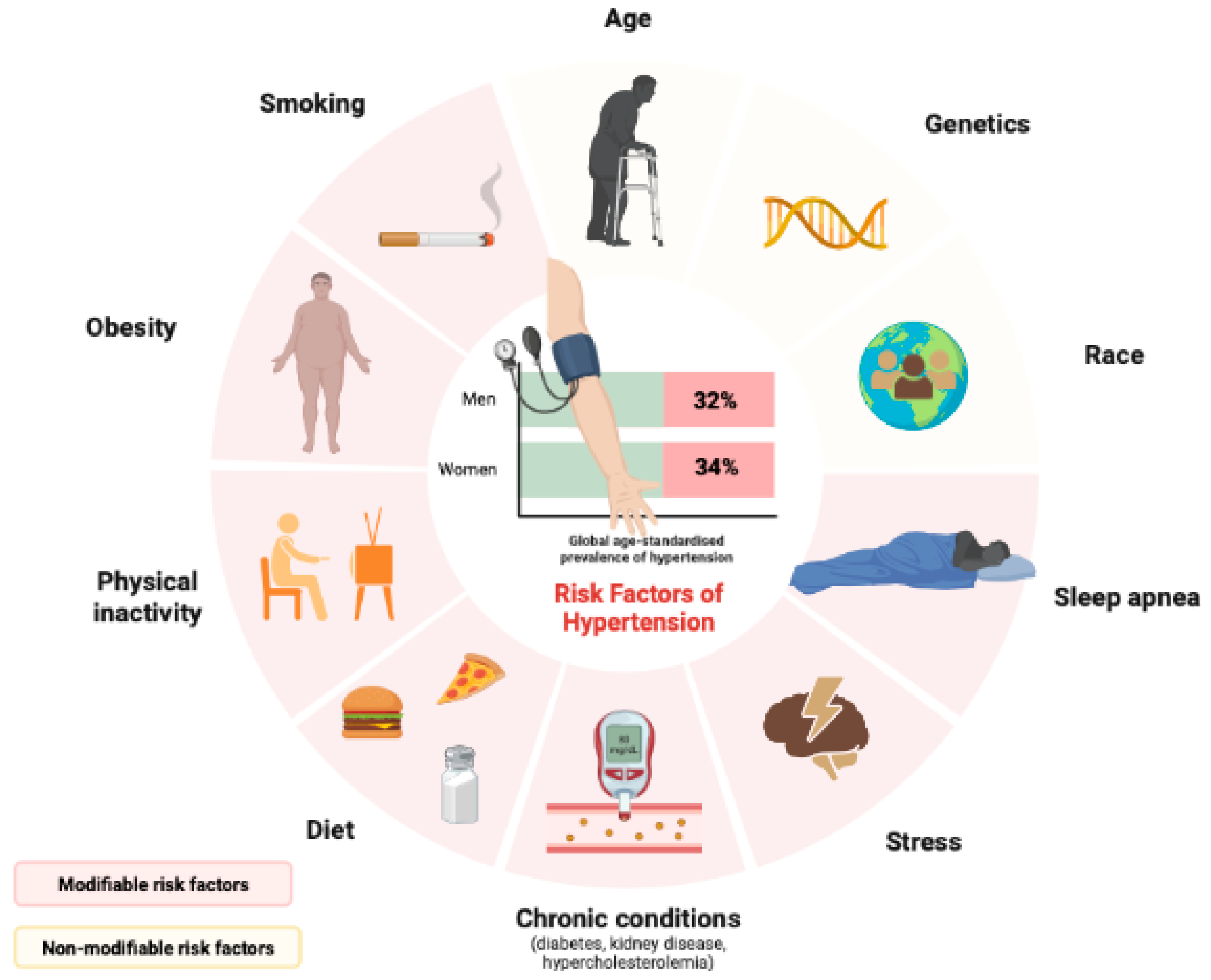
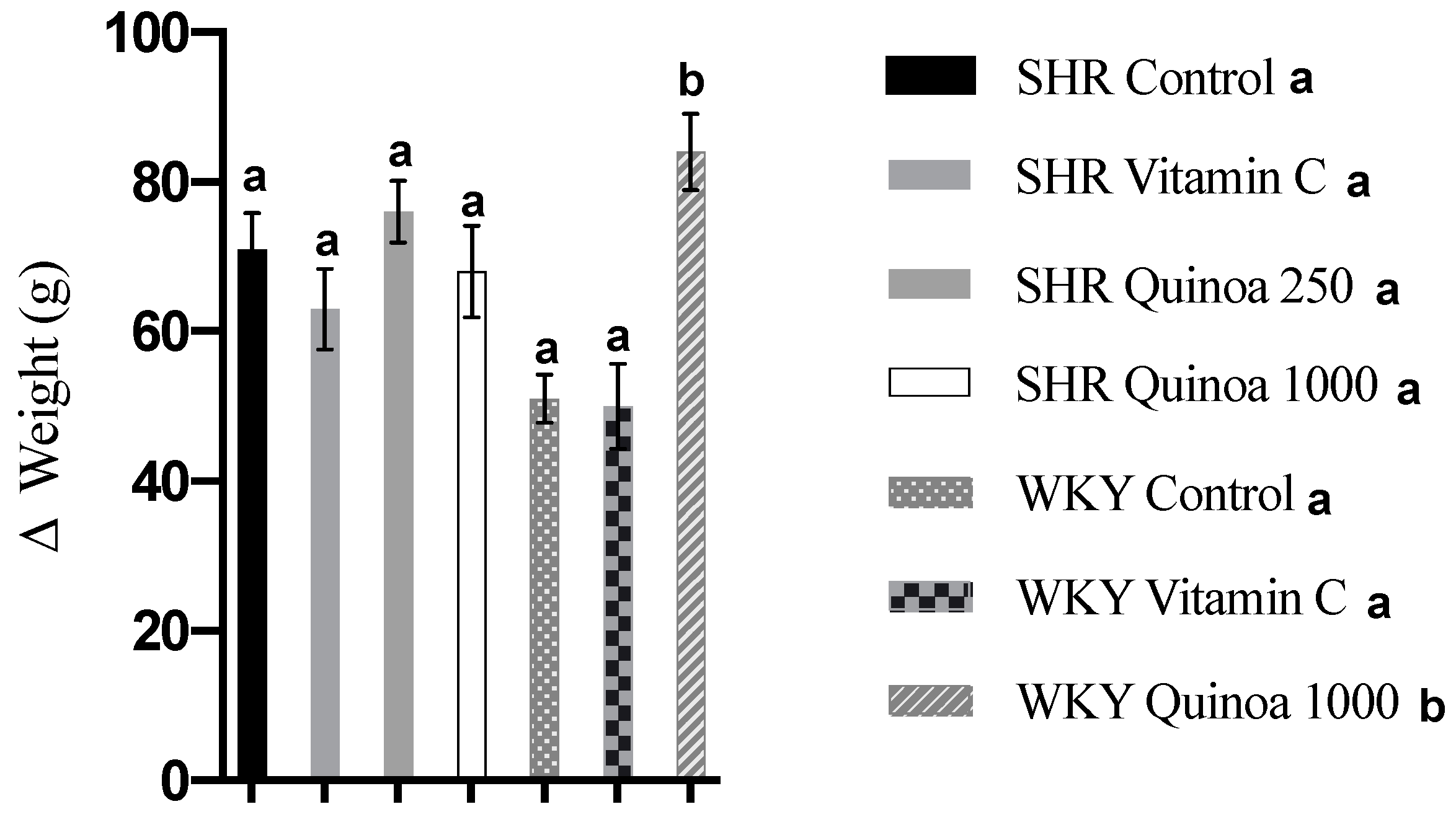
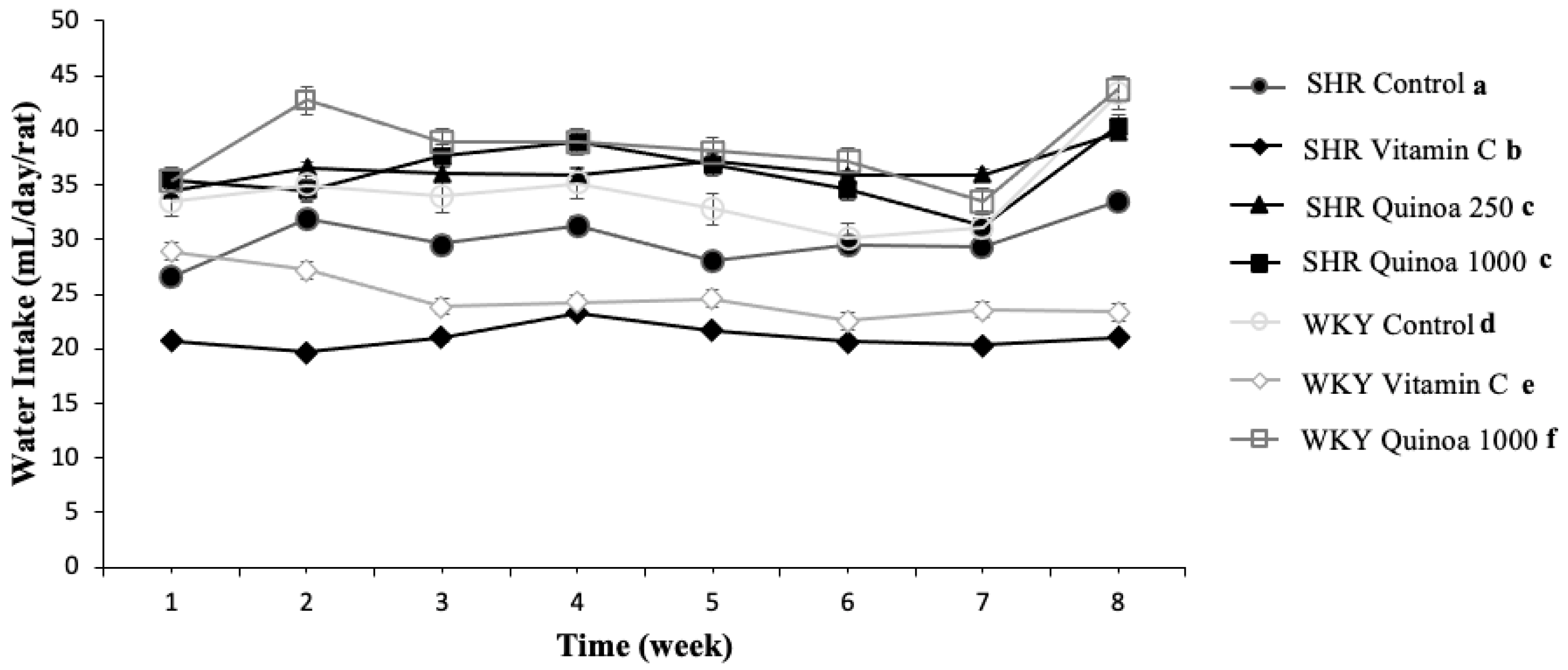
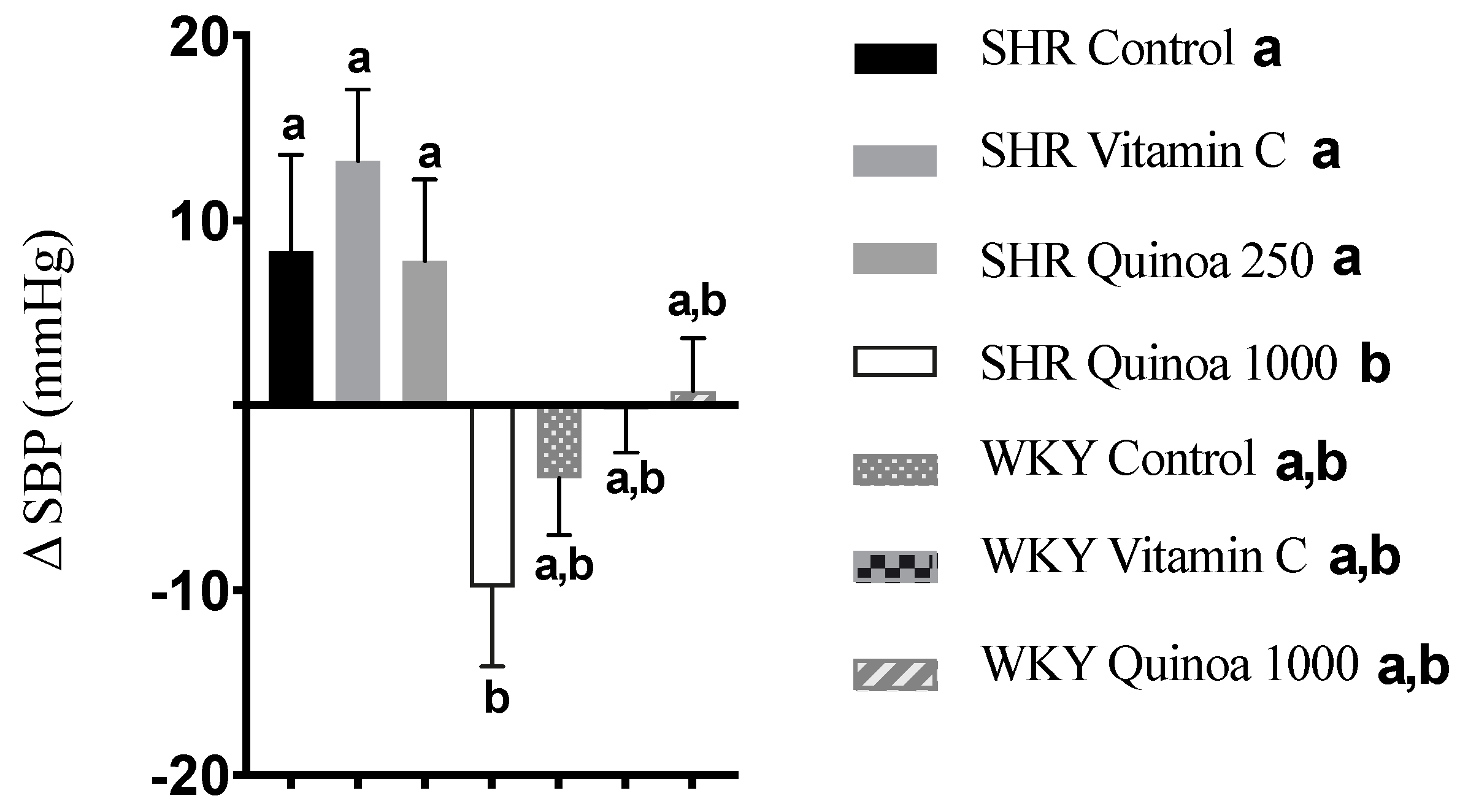
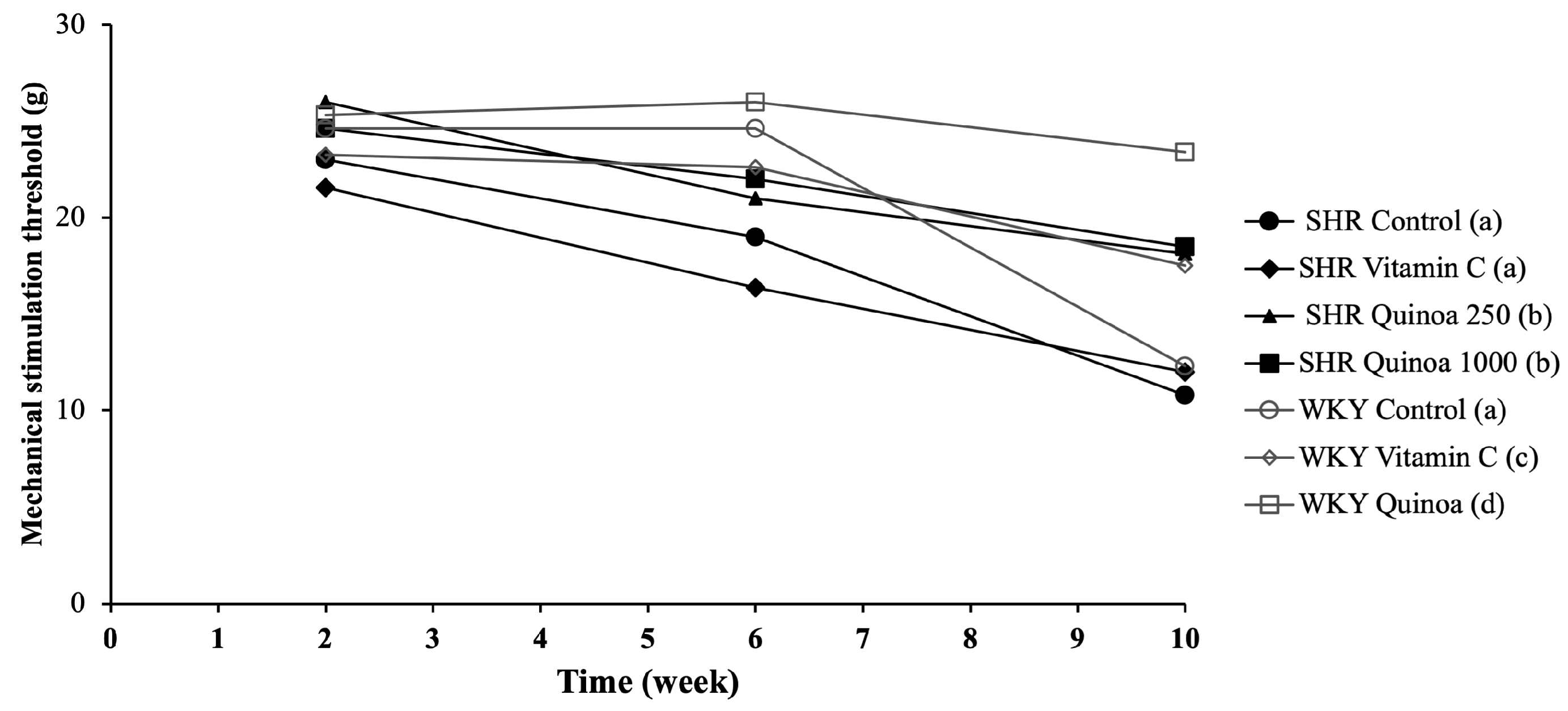
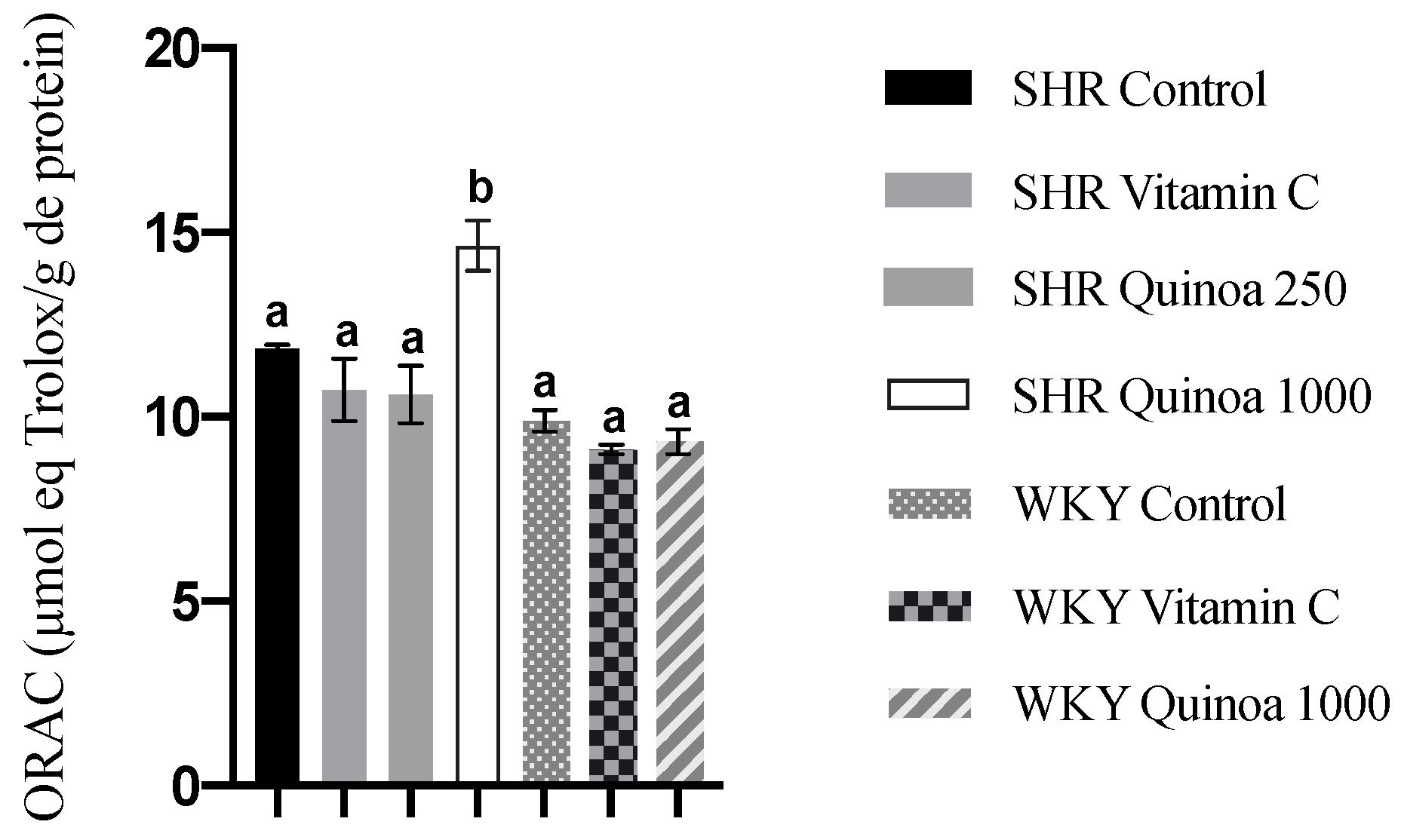
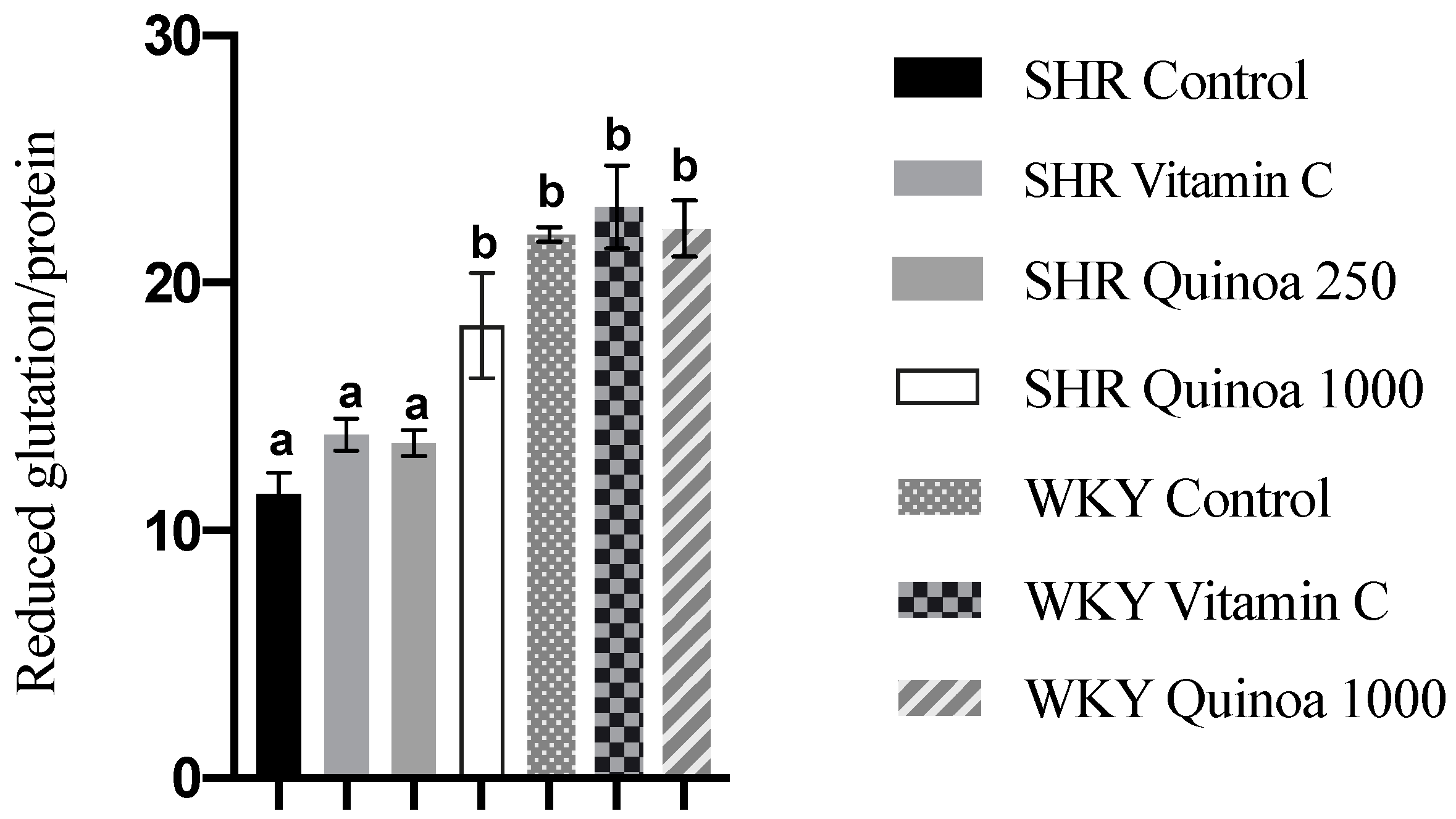
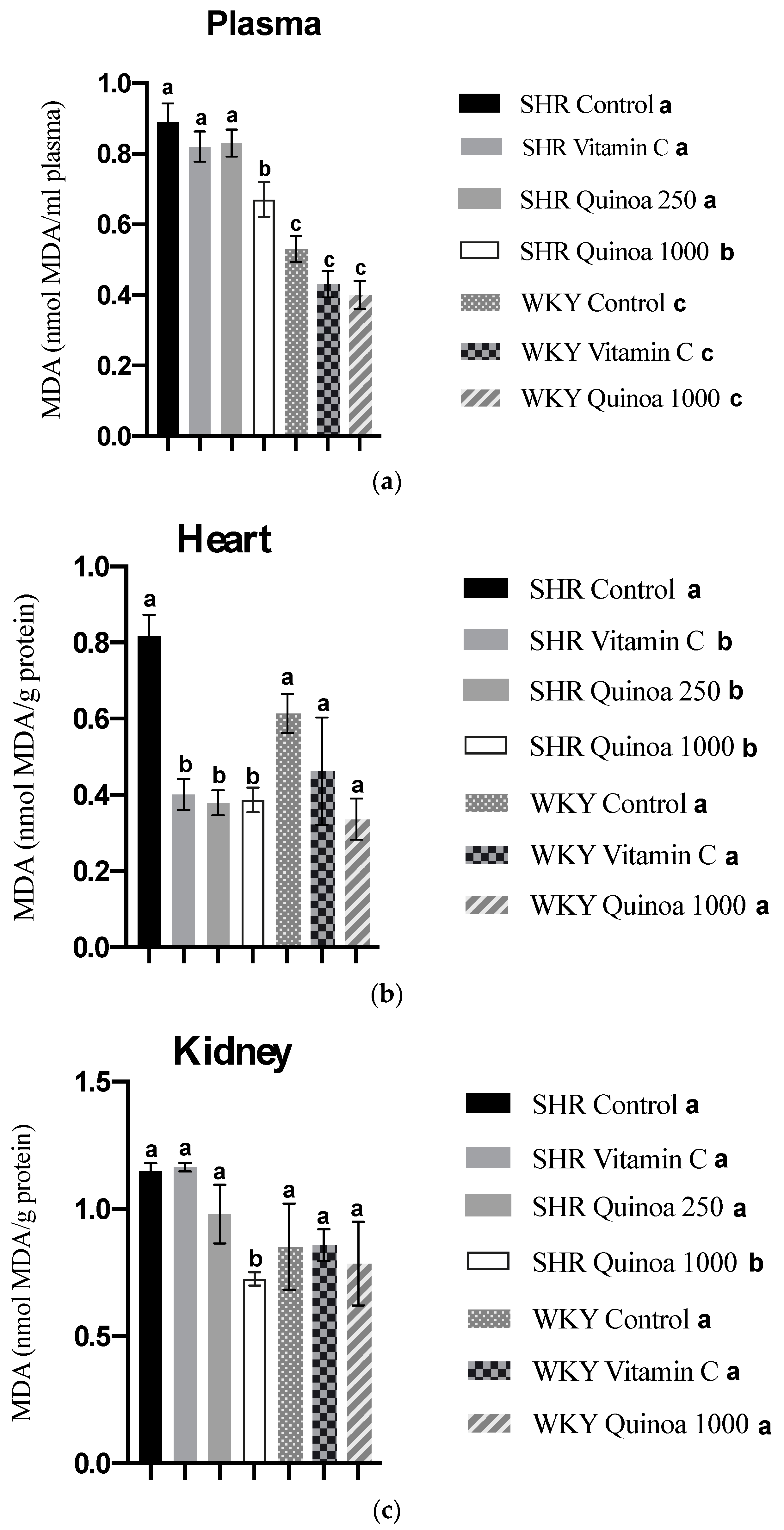
| Experimental Groups Organ Weight (g) | SHR Control | SHR Vitamin C | SHR Quinoa 250 | SHR Quinoa 1000 | WKY Control | WKY Vitamin C | WKY Quinoa 1000 |
|---|---|---|---|---|---|---|---|
| Brain (g) | 0.69 ± 0.02 | 0.61 ± 0.01 | 0.63 ± 0.03 | 0.64 ± 0.02 | 0.71 ± 0.02 | 0.71 ± 0.02 | 0.66 ± 0.02 |
| Heart (g) | 0.43 ± 0.02 | 0.44 ± 0.02 | 0.40 ± 0.01 | 0.44 ± 0.02 | 0.41 ± 0.02 | 0.37 ± 0.01 | 0.38 ± 0.01 |
| Lungs (g) | 0.52± 0.03 | 0.46 ± 0.03 | 0.54 ± 0.03 | 0.50 ± 0.03 | 0.72 ± 0.03 | 0.48 ± 0.02 | 0.52 ± 0.03 |
| Liver (g) | 3.35 ± 0.16 a | 3.13 ± 0.19 a | 2.95 ± 0.12 ab | 2.91 ± 0.12 b | 2.94 ± 0.13 a | 2.95 ± 0.14 a | 2.86 ± 0.09 a |
| Spleen (g) | 0.22 ± 0.01 | 0.19 ± 0.01 | 0.20 ± 0.01 | 0.22 ± 0.02 | 0.24 ± 0.02 | 0.22 ± 0.01 | 0.21 ± 0.01 |
| Kidney (g) | 0.81 ± 0.04 | 0.74 ± 0.04 | 0.74 ± 0.05 | 0.78 ± 0.05 | 0.69 ± 0.11 | 0.78 ± 0.03 | 0.69 ± 0.09 |
| Epididymal adipose tissue (g) | 1.33 ± 0.05 | 1.22 ± 0.08 | 1.29 ± 0.07 | 1.40 ± 0.06 | 1.41 ± 0.06 | 1.33 ± 0.07 | 1.42 ± 0.04 |
| Muscle (g) | 0.11 ± 0.03 | 0.05 ± 0.01 | 0.07 ± 0.02 | 0.06 ± 0.01 | 0.06 ± 0.01 | 0.05 ± 0.00 | 0.05 ± 0.00 |
| Tibia (g) | 1.13 ± 0.02 | 1.16 ± 0.03 | 1.11 ± 0.02 | 1.14 ± 0.04 | 1.09 ± 0.06 | 1.16 ± 0.03 | 1.09 ± 0.03 |
Disclaimer/Publisher’s Note: The statements, opinions and data contained in all publications are solely those of the individual author(s) and contributor(s) and not of MDPI and/or the editor(s). MDPI and/or the editor(s) disclaim responsibility for any injury to people or property resulting from any ideas, methods, instructions or products referred to in the content. |
© 2023 by the authors. Licensee MDPI, Basel, Switzerland. This article is an open access article distributed under the terms and conditions of the Creative Commons Attribution (CC BY) license (https://creativecommons.org/licenses/by/4.0/).
Share and Cite
López-Moreno, M.; Jiménez-Moreno, E.; Márquez Gallego, A.; Vera Pasamontes, G.; Uranga Ocio, J.A.; Garcés-Rimón, M.; Miguel-Castro, M. Red Quinoa Hydrolysates with Antioxidant Properties Improve Cardiovascular Health in Spontaneously Hypertensive Rats. Antioxidants 2023, 12, 1291. https://doi.org/10.3390/antiox12061291
López-Moreno M, Jiménez-Moreno E, Márquez Gallego A, Vera Pasamontes G, Uranga Ocio JA, Garcés-Rimón M, Miguel-Castro M. Red Quinoa Hydrolysates with Antioxidant Properties Improve Cardiovascular Health in Spontaneously Hypertensive Rats. Antioxidants. 2023; 12(6):1291. https://doi.org/10.3390/antiox12061291
Chicago/Turabian StyleLópez-Moreno, Miguel, Estefanía Jiménez-Moreno, Antonio Márquez Gallego, Gema Vera Pasamontes, José Antonio Uranga Ocio, Marta Garcés-Rimón, and Marta Miguel-Castro. 2023. "Red Quinoa Hydrolysates with Antioxidant Properties Improve Cardiovascular Health in Spontaneously Hypertensive Rats" Antioxidants 12, no. 6: 1291. https://doi.org/10.3390/antiox12061291
APA StyleLópez-Moreno, M., Jiménez-Moreno, E., Márquez Gallego, A., Vera Pasamontes, G., Uranga Ocio, J. A., Garcés-Rimón, M., & Miguel-Castro, M. (2023). Red Quinoa Hydrolysates with Antioxidant Properties Improve Cardiovascular Health in Spontaneously Hypertensive Rats. Antioxidants, 12(6), 1291. https://doi.org/10.3390/antiox12061291








